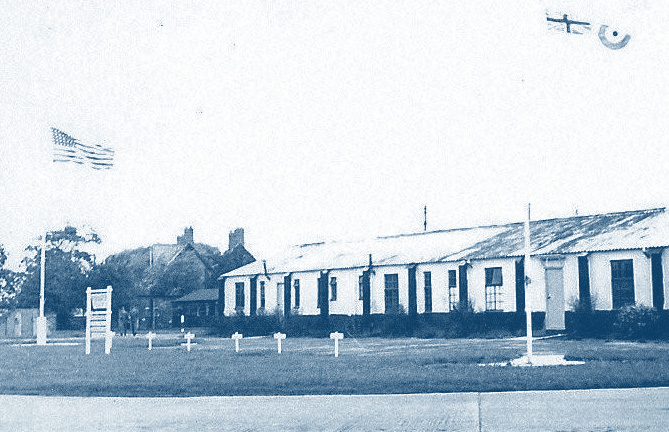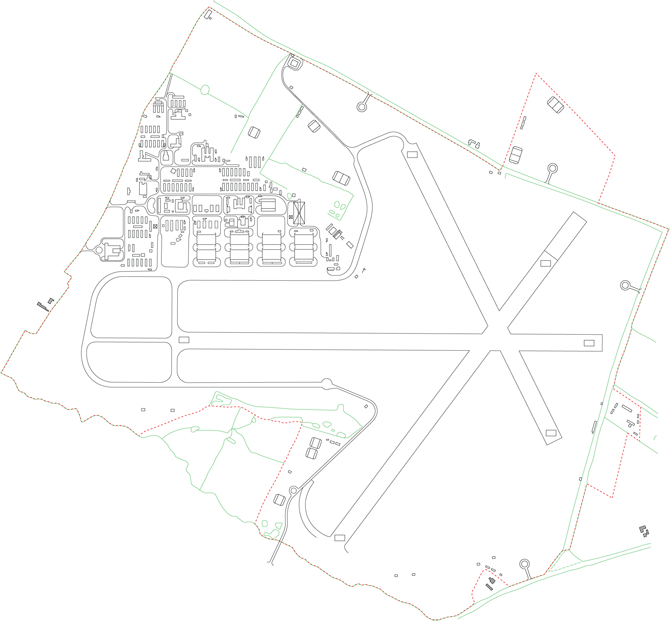
 During the months of June, July and August of 1939 Air ministry planners were looking for a large area of suitably flat land on which they could construct another 'only for the period of the war' airfield. On one of their reconnaissance trips through Cheshire they came across Earnshaw Hall, a large farmhouse surrounded by 490 acres of open fields. A compulsory purchase order was handed to the owner along with those living at other farms within the required area and in the December of that year John Mowlem Construction moved onto the land filling ditches, clearing hedges, trees and with the exception of Earnshaw Hall farmhouse itself all buildings.
During the months of June, July and August of 1939 Air ministry planners were looking for a large area of suitably flat land on which they could construct another 'only for the period of the war' airfield. On one of their reconnaissance trips through Cheshire they came across Earnshaw Hall, a large farmhouse surrounded by 490 acres of open fields. A compulsory purchase order was handed to the owner along with those living at other farms within the required area and in the December of that year John Mowlem Construction moved onto the land filling ditches, clearing hedges, trees and with the exception of Earnshaw Hall farmhouse itself all buildings.
In an excerpt from his letter, to Mrs Charlotte Peters Rock, local farmer Charles Yarwood shares his memories of what happened:
"I was 19 at the time when the Air Ministry requisitioned the farmland, several acres were involved and several farmhouses were demolished. Traction engines were brought in to pull up trees and to cart them away. Tom Ollier [another local farmer] had three sets of horses and carts at Holly House Farm, which were hired to the contractors [Jones from Wrexham] to move timber and the remains of the houses.
Things happened very quickly in those days and I remember my father being compensated for the crops on the land – we could salvage what we could at our own risk so we worked day and night on this. We did quite well. As far as I can remember, looking at the map, they made runway 16-34 first then 10-28 and then 05-23. It was a sort of metal mesh the grass grew through it and looked like farmland. At the same time they were building the base, they never stopped working on that; they certainly put up a fence around the airfield. Of course it was a Navigation and Pilot training base to start but with the outbreak of war it became a fighter unit – this was early 1941 – all sorts of aeroplanes arrived at this time but mainly Hurricanes of 96 Squadron. It was about this time I joined the Home Guard."
 Ground clearance and construction of over 250 buildings, most of which were to Air Ministry standard blueprints, started almost immediately. It is known that some buildings, such as the air raid shelters, were built not to Air Ministry standards, but to an unknown specification. All other buildings were either Permanent brick, such as the sub-stations, Temporary brick [single 4½ inch thick wall] or timber, Nissen, handcraft or curved asbestos huts. The construction of roads and taxiways continued through the winter and spring months, where possible, and into summer of the following year.
Ground clearance and construction of over 250 buildings, most of which were to Air Ministry standard blueprints, started almost immediately. It is known that some buildings, such as the air raid shelters, were built not to Air Ministry standards, but to an unknown specification. All other buildings were either Permanent brick, such as the sub-stations, Temporary brick [single 4½ inch thick wall] or timber, Nissen, handcraft or curved asbestos huts. The construction of roads and taxiways continued through the winter and spring months, where possible, and into summer of the following year.
Photo: Station H.Q. and the former Earnshaw Hall farmhouse.
This picture is from the 1955-1957 period when the 620th Engineers U.S. Army were using the site. In it’s time the farmhouse was used as the W.A.A.F. Officers’ Mess and the Dental Centre. It is shown on the site plan as building no. 149.
All material on the web site is covered by copyright © 2010 - 2016